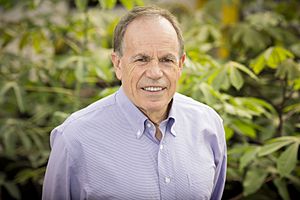Stephen P. Long facts for kids
Quick facts for kids
Stephen Long
|
|
|---|---|
 |
|
| Born |
Stephen Patrick Long
13 August 1950 London, England
|
| Died | 9 September 2025 (aged 75) |
| Citizenship | United States |
| Alma mater |
|
| Spouse(s) | Ann Long |
| Children | 2 |
| Awards | Member of the National Academy of Sciences (2019) |
| Scientific career | |
| Fields |
|
| Institutions | |
| Thesis | C4 photosynthesis in cool temperate climates, with reference to Spartina townsendii (S.L.) in Britain (1976) |
| Doctoral advisor | Dr. H.W. Woolhouse |
| Doctoral students | Lisa Ainsworth |
Stephen Patrick Long (born August 13, 1950 – died September 9, 2025) was a very important scientist. He was a British-born American plant physiologist. This means he studied how plants work. He was also a member of the National Academy of Sciences.
Dr. Long spent his career trying to make plants better. He wanted to improve photosynthesis. Photosynthesis is how plants use sunlight to make their own food. By making it better, he hoped to grow more food and crops for fuel. He worked as a professor at the University of Illinois. He also taught at Lancaster University and University of Oxford in the UK.
His research showed that we can change photosynthesis. This can help plants grow more. This was a huge discovery in plant science. Dr. Long also helped us understand climate change. He studied how more carbon dioxide and ozone affect plants. He even shared his ideas with important people. These included former President George W. Bush and Bill Gates. He talked about food security and plant-based energy.
Contents
Growing Up and Going to School
Stephen Long was born in London, England. He grew up there. His high school biology teacher made him love plants. He also saw how people suffered from famines in the 1960s. This made him want to help grow more food.
He studied plants at University of Reading. He got his first degree in 1972. Then he earned a special doctorate degree. This was from University of Leeds in 1976. It was about how plants react to their environment. Later, in 2007, Lancaster University gave him another special degree. This was for all his great work in environmental science.
Stephen Long's Amazing Work with Plants
Dr. Long started his teaching career in 1975. He worked at the University of Essex. He became a full professor there in 1990. Later, in 1999, he moved to the University of Illinois. He held important professor roles there.
He also worked at many other famous places. These included the Smithsonian Institution. He also worked at Brookhaven National Laboratory.
Big Projects for Better Plants
In 2007, Dr. Long helped start something huge. It was called the Energy Biosciences Institute (EBI). This project aimed to find new ways to create energy from plants. It was a big partnership. Many universities and companies worked together.
In 2012, he started leading a new project. It was called Realizing Increased Photosynthetic Efficiency (RIPE). This project got funding from the Bill & Melinda Gates Foundation. Its goal was to make plants use sunlight more efficiently. This would help grow more food for everyone. The RIPE project received even more funding later on.
Dr. Long also led other important projects. These included PETROSS and TERRA-MEPP. These projects focused on making plants better for fuel and energy. He also advised the U.S. government on plant-based energy.
Discoveries and Innovations
Dr. Long was a very busy scientist. He wrote over 400 scientific papers. These were published in top journals like Nature and Science.
He found some of the most productive land plants. For example, he identified Miscanthus. This plant became a great source for bioenergy. He also created the first computer model. This model showed the entire process of photosynthesis.
One of his biggest achievements was the SoyFACE project. This was a huge outdoor lab. It studied how future climate changes would affect crops.
In 2016, his team made a big breakthrough. They showed that plants could be engineered. This made them grow more food. This discovery was published in Science. It was even called one of the top science moments of the year.
His team also engineered a crop. This crop needed 25% less water. But it still grew just as much food. This was done by changing just one gene in the plant. This amazing work was reported in Nature Communications.
Sharing Knowledge: Journals
Dr. Long also loved sharing scientific knowledge. He started and edited a journal called Global Change Biology. He also founded GCB Bioenergy. This journal became very important for bioenergy research. In 2018, he launched another journal. It was called in silico Plants. This journal combined plant biology with computer science.
His Passing
Stephen Long passed away on September 9, 2025. He had been battling pancreatic cancer for about a year and a half.
Awards and Special Recognitions
Stephen Long received many awards for his important work. He was recognized as a top researcher in plant science. This happened every year since 2005.
In 2007, he became a fellow of the American Association for the Advancement of Science. This is a very respected group. He also gave special lectures at famous universities. These included the University of Oxford and Imperial College London.
In 2012, he received the Charles F. Kettering Award. This was for his excellent research on photosynthesis. He also got the Marsh Award for his work on climate change.
A very high honor came in 2013. He was elected a Fellow of the Royal Society (FRS). This is one of the oldest and most respected scientific societies. It honors leading scientists. In 2019, he was also elected to the National Academy of Sciences. This is another huge honor for scientists in the United States.
He was truly one of "The World's Most Influential Scientific Minds."

